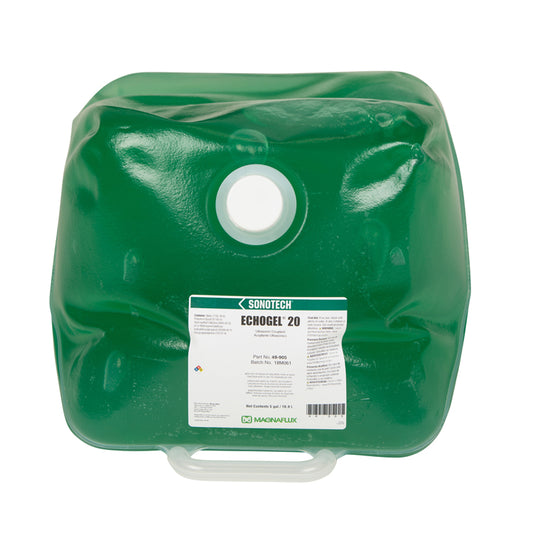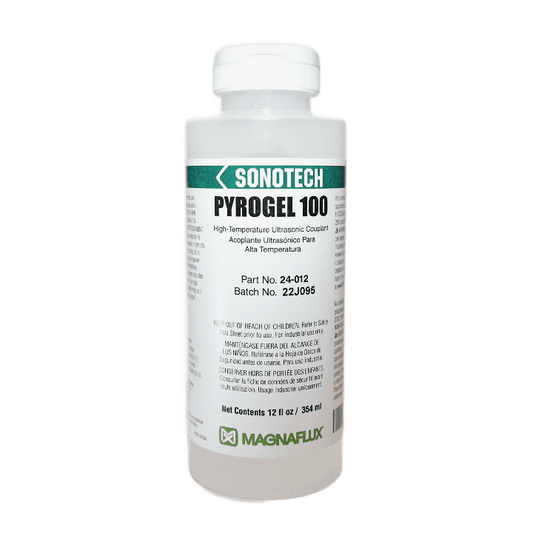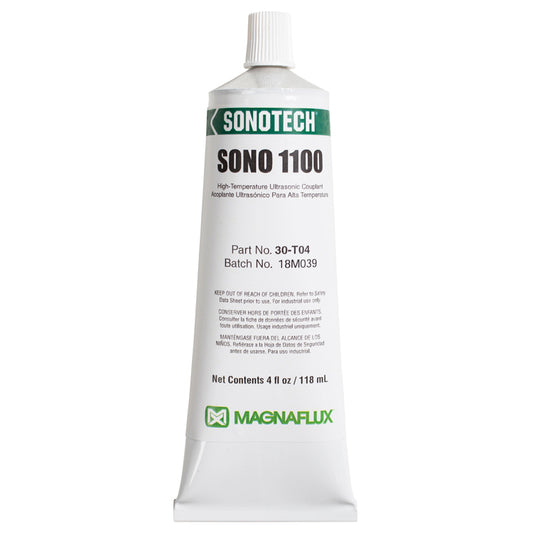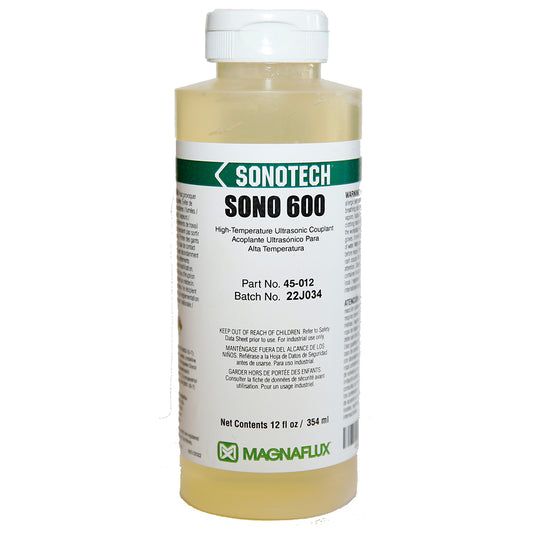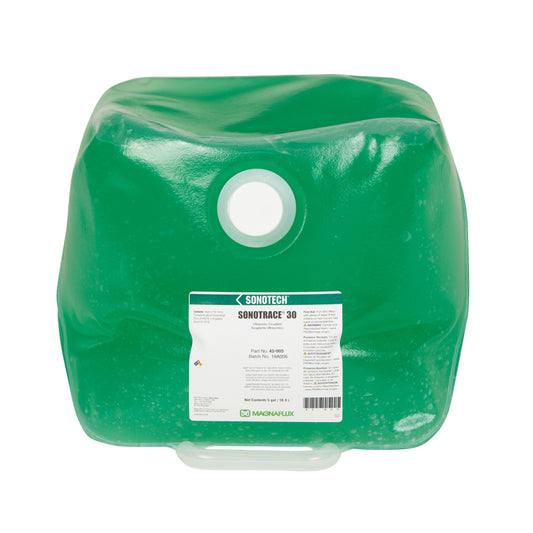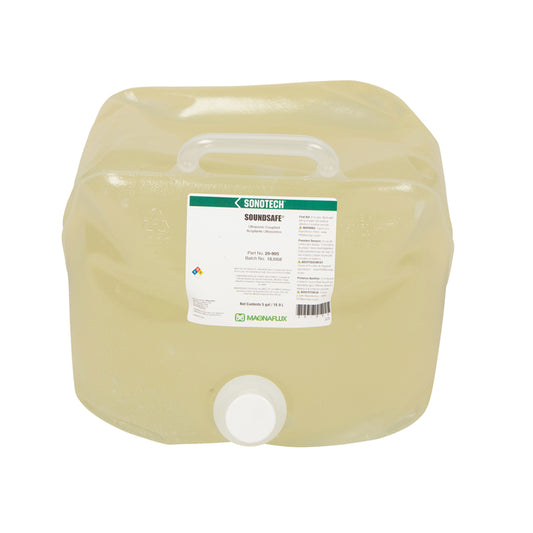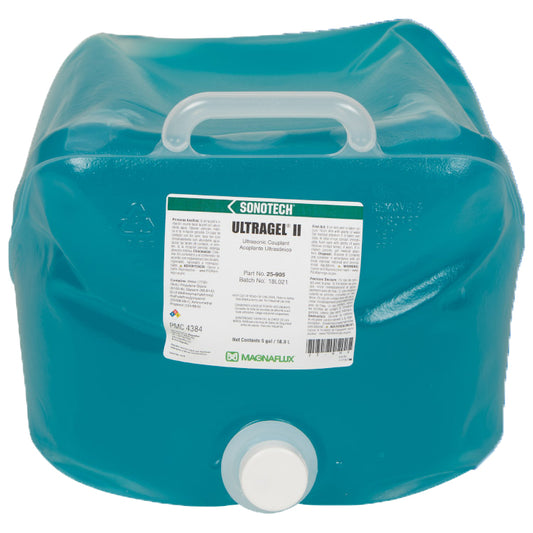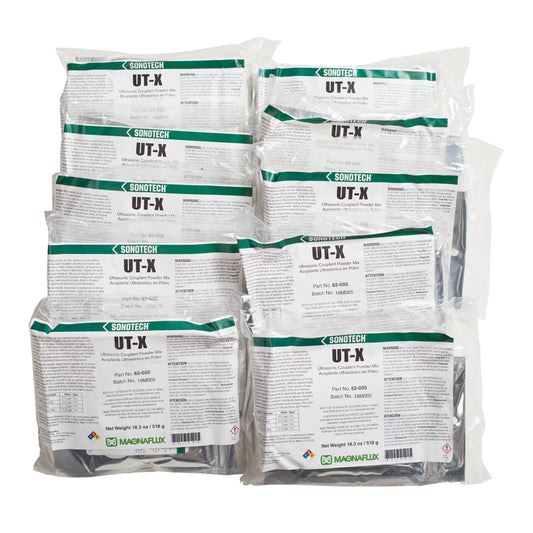Collection: Ultrasonic Couplants
-
Echogel 20
Regular price From $79.00Regular priceUnit price / per -
Pyrogel GR 100
Regular price From $930.00Regular priceUnit price / per -
Sonotrace 30
Regular price From $81.00Regular priceUnit price / per -
Ultragel II
Regular price From $101.00Regular priceUnit price / per -
UT-X Powder - Ultrasonic Testing Couplant Gel
Regular price From $27.25Regular priceUnit price / per
Ultrasonic testing involves imparting ultrasonic energy from a transducer into a part and back to assess the integrity of that part. Ultrasonic energy does not travel very well through air, so if there is air between the transducer and the part, very little energy is transferred and poor readings result.
- Couplants fill in the gaps, eliminating the air in the space between the part and the transducer, and transmitting more ultrasonic energy into and out of the part.
- The surface texture of the part is important, as rough part surfaces tend to have more spaces for air to exist between the part and the transducer, and therefore have even greater need for a couplant to be used.
Magnaflux couplants are formulated and approved for use in NDT applications, with multiple options available to fill in gaps on various part surfaces and under different conditions. View the Industrial Ultrasonic Couplant Comparison guide here.
Why Choose Magnaflux Ultrasonic Testing Couplants?
- Slow drying time, allowing for longer, in-depth inspections
- Products made for a wide variety of applications, including aerospace and varied temperature settings
- Line of thixotropic products (Ultragel II, Soundsafe) for vertical and overhead surfaces
- Compliance with leading industry standards
- Non-toxic, non-irritating formulas keep operators safe without reducing accuracy
Ultrasonic Testing Couplants - Complete Buying Guide
Introduction
Ultrasonic testing (UT) couplants serve as the critical "bridge" between your transducer and test piece, enabling ultrasonic energy to travel effectively through the interface. The right couplant maximizes energy transmission while minimizing interference, cleanup time, and costs. This guide will help you select the optimal couplant for your specific application.
Understanding Couplant Function
Primary Purpose:
- Transfer maximum ultrasonic energy from transducer to test piece
- Efficiently return reflected energy back to the transducer
- Eliminate air gaps that prevent sound transmission
Why Couplants Matter: Sound energy travels poorly between materials of different densities (like air and metal). The goal of selecting the right UT couplant is to maximize the amount of energy transmitted over the "bridge" while at the same time minimizing risk, cost, time, clean-up, etc.
Key Selection Criteria
1. Part Characteristics
Surface Texture:
- Rough Surfaces: Require thicker, higher-viscosity couplants to fill gaps and ridges
- Smooth/Machined Surfaces: Benefit from thin couplants that allow easy transducer movement
Material Type:
- Ensure couplant compatibility with your test material
- Consider corrosion resistance requirements
- Verify approval for specific alloys (aerospace, nuclear, etc.)
- Some couplants are safe for plastics and fiberglass
Part Size:
- Large Areas: Choose self-leveling couplants with good wetting characteristics
- Small Areas: Standard viscosity couplants are typically sufficient
2. Environmental Conditions
Inspection Angle:
- Horizontal: Most couplants suitable
- Vertical/Overhead: Require higher viscosity couplants that cling to surfaces
Temperature Considerations:
High Temperature Applications:
- Use couplants specifically formulated for high-temperature service
- Check auto-ignition temperature (never exceed this limit)
- Consider flash point reduction in closed environments
- Account for viscosity changes at operating temperature
Low Temperature Applications:
- Avoid water-based couplants (freeze risk)
- Choose silicone or glycol-based formulations
- Consider "winterizing" with propylene glycol (manufacturer approval required)
3. Inspection Type
Flaw Detection & Defect Sizing:
- Wide range of couplants suitable
- Typically short-duration inspections
- Focus on transmission efficiency
Thickness Gauging:
- May require high-temperature capability
- Salt resistance important for marine/bridge applications
- Some thickeners degrade quickly in salt presence
Flow Metering:
- Long-term applications require non-drying formulations
- Glycol or silicone-based couplants preferred
- Excellent corrosion protection essential
Shear Wave Testing:
- Requires very thick, high-viscosity couplants
- Gel/liquid couplants cannot support shear stress
- Use thinnest possible layer despite high viscosity
4. Regulatory & Industry Requirements
Common Specifications:
- API (American Petroleum Institute)
- ASME BPVC (Boiler and Pressure Vessel Code)
- AWS (American Welding Society)
Nuclear Industry:
- Very low halogen content required
- Minimal sulfur content
- Strict contamination controls
Aerospace Applications:
- Independent testing for corrosion resistance
- Stress crack and hydrogen embrittlement testing
- Multi-alloy compatibility verification
Couplant Types & Applications
Water-Based Couplants
Best For:
- General-purpose applications
- Room temperature testing
- Cost-sensitive applications
Limitations:
- Freeze at low temperatures
- May require additives for extreme conditions
Glycol-Based Couplants
Best For:
- Low-temperature applications
- Long-term flow metering
- Freeze resistance required
Advantages:
- Excellent temperature stability
- Good wetting properties
- Corrosion resistance
Silicone-Based Couplants
Best For:
- Extreme temperature ranges
- Long-term applications
- Chemical resistance required
Advantages:
- Wide temperature range
- Excellent stability
- Non-reactive with most materials
High-Temperature Couplants
Best For:
- Hot pipe inspections
- High-temperature process equipment
- Elevated temperature thickness gauging
Key Specifications:
- Operating temperature range
- Auto-ignition temperature
- Flash point considerations
Selection Decision Matrix
Ask These Five Critical Questions:
-
What parts are you inspecting?
- Surface texture requirements
- Material compatibility
- Size considerations
-
What are your environmental conditions?
- Temperature range
- Inspection angle
- Atmospheric conditions
-
What type of UT inspection?
- Flaw detection vs. thickness gauging
- Contact time requirements
- Precision needs
-
What approvals are required?
- Industry specifications
- Quality standards
- Regulatory compliance
-
What other factors matter?
- Inspection volume
- Cost considerations
- Cleanup requirements
Viscosity Guidelines
Viscosity Ranges (Typical):
-
Thin/Low Viscosity: 500-5,000 cps
- Smooth surfaces, easy application
-
Medium Viscosity: 65,000-80,000 cps
- General-purpose applications
-
High Viscosity: 500,000+ cps
- Vertical surfaces, shear wave testing
-
Extra High Viscosity: 4,000,000+ cps
- Extreme conditions, maximum adhesion
Cost-Benefit Analysis
Factors to Consider:
- Initial Cost: Price per unit volume
- Application Efficiency: Coverage per unit
- Cleanup Time: Labor costs for removal
- Part Risk: Critical vs. non-critical components
- Inspection Volume: Frequency of use
Cost Optimization Tips:
- Match viscosity to actual needs (don't over-specify)
- Consider concentrated formulations
- Evaluate cleanup requirements
- Factor in specification compliance costs
Quality Assurance
Verification Steps:
-
Material Compatibility Testing
- Corrosion resistance verification
- Stress crack testing (if required)
- Long-term exposure testing
-
Performance Validation
- Transmission efficiency testing
- Temperature performance verification
- Viscosity stability confirmation
-
Documentation Review
- Specification compliance certificates
- Safety data sheets
- Traceability documentation
Storage & Handling
Storage Requirements:
- Temperature control (avoid freezing/overheating)
- Contamination prevention
- Shelf life monitoring
- Proper ventilation
Handling Best Practices:
- Use appropriate dispensing equipment
- Minimize contamination introduction
- Follow safety protocols
- Maintain inventory rotation
Troubleshooting Common Issues
Poor Transmission:
- Check viscosity match to application
- Verify surface preparation
- Confirm temperature suitability
- Evaluate contamination levels
Cleanup Problems:
- Select appropriate removal method
- Consider couplant formulation
- Evaluate surface compatibility
- Review application thickness
Corrosion Issues:
- Verify material compatibility
- Check couplant purity
- Evaluate exposure time
- Consider inhibitor additives
Final Recommendations
Before Making Changes:
- Evaluate current couplant performance
- Identify specific improvement needs
- Consider total cost of ownership
- Validate new selection thoroughly
Selection Best Practices:
- Start with manufacturer recommendations
- Consider application-specific formulations
- Validate performance before full implementation
- Maintain documentation of selection criteria
Quality Assurance:
- Source from reputable NDT suppliers
- Verify specification compliance
- Maintain traceability records
- Implement regular performance reviews
Conclusion
Selecting the right ultrasonic testing couplant requires careful consideration of your specific application requirements, environmental conditions, and regulatory needs. By systematically evaluating these factors and following this guide, you can optimize your UT inspection performance while minimizing costs and risks.
Remember that the most expensive couplant isn't always the best choice, but for critical applications, investing in proper specification-compliant couplants from trusted manufacturers is essential for reliable results and regulatory compliance.


